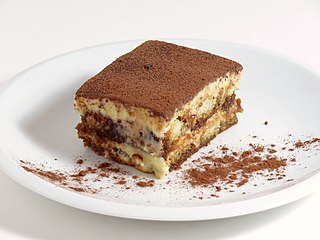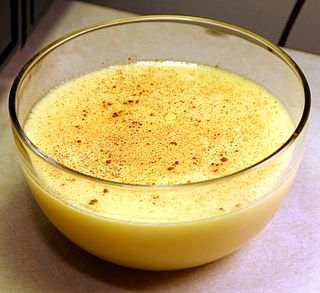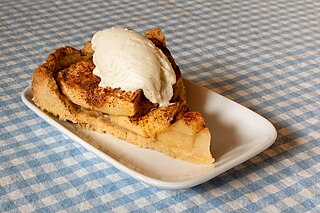
Tiramisu is a coffee-flavoured Italian dessert. It is made of ladyfingers (savoiardi) dipped in coffee, layered with a whipped mixture of eggs, sugar and mascarpone, flavoured with cocoa. The recipe has been adapted into many varieties of cakes and other desserts. Its origin is disputed between the Italian regions of Veneto and Friuli Venezia Giulia. The name comes from the Italian tirami su.

Custard is a variety of culinary preparations based on sweetened milk, cheese, or cream cooked with egg or egg yolk to thicken it, and sometimes also flour, corn starch, or gelatin. Depending on the recipe, custard may vary in consistency from a thin pouring sauce to the thick pastry cream used to fill éclairs. The most common custards are used in custard desserts or dessert sauces and typically include sugar and vanilla; however, savory custards are also found, e.g., in quiche.

Pastry is baked food made with a dough of flour, water, and shortening that may be savoury or sweetened. Sweetened pastries are often described as bakers' confectionery. The word "pastries" suggests many kinds of baked products made from ingredients such as flour, sugar, milk, butter, shortening, baking powder, and eggs. Small tarts and other sweet baked products are called pastries as a synecdoche. Common pastry dishes include pies, tarts, quiches, croissants, and pasties.

A semla, vastlakukkel, laskiaispulla, Swedish eclair, fastlagsbulle/fastelavnsbolle or vēja kūkas is a traditional sweet roll made in various forms in Sweden, Finland, Norway, Denmark, the Faroe Islands, Iceland, Estonia, and Latvia, associated with Lent and especially Shrove Tuesday in most countries, Shrove Monday in Denmark, parts of southern Sweden, Iceland and Faroe Islands or Sunday of Fastelavn in Norway. In Sweden it is most commonly known as just semla, but is also known as fettisdagsbulle, lit. 'Fat Tuesday bun' or 'Shrove Tuesday bun'. In the southern parts of Sweden, as well as in Swedish-speaking Finland, it is known as fastlagsbulle. In Poland it is known as ptyś. In Estonia it is called vastlakukkel. In Norway and Denmark it is called fastelavnsbolle. In Iceland, it is known as a bolla and served on Bolludagur. In Faroe Islands it is called Føstulávintsbolli, and is served on Føstulávintsmánadagur. In Latvia, it is called vēja kūkas. Semla served in a bowl of hot milk is hetvägg.

A profiterole, cream puff (US), or chou à la crème is a filled French choux pastry ball with a typically sweet and moist filling of whipped cream, custard, pastry cream, or ice cream. The puffs may be decorated or left plain or garnished with chocolate sauce, caramel, or a dusting of powdered sugar. Savory profiterole are also made, filled with pureed meats, cheese, and so on. These were formerly common garnishes for soups.

A mille-feuille, also known by the names Napoleon in North America, vanilla slice in the United Kingdom, and custard slice, is a French dessert made of puff pastry layered with pastry cream. Its modern form was influenced by improvements made by Marie-Antoine Carême.

Advocaat or advocatenborrel is a traditional Dutch alcoholic beverage made from eggs, sugar, and brandy. The rich and creamy drink has a smooth, custard-like consistency. The typical alcohol content is generally between 14% and 20% ABV. Its contents may be a blend of egg yolks, aromatic spirits, sugar or honey, brandy, vanilla, and sometimes cream. Notable makers of advocaat include Warninks, Bols, Darna Ovo Liker, DeKuyper, and Verpoorten.

Apple cakes are cakes in which apples feature as a main flavour and ingredient. Such cakes incorporate apples in a variety of forms, including diced, pureed, or stewed, and can include common additions like raisins, nuts, and 'sweet' spices such as cinnamon or nutmeg. They are a common and popular dessert worldwide, thanks to millennia of apple cultivation in Asia and Europe, and their widespread introduction and propagation throughout the Americas during the Columbian Exchange and colonisation. As a result, apple desserts, including cakes, have a huge number of variations.

Choux pastry, or pâte à choux, is a delicate pastry dough used in many pastries. The essential ingredients are butter, water, flour and eggs.

A tompoes or tompouce is a pastry in the Netherlands and Belgium. It is the local variety of the mille-feuille or Napoleon, introduced by an Amsterdam pastry baker and named after Admiraal Tom Pouce, the stage name of the Frisian dwarf Jan Hannema.

A pastry bag is an often cone- or triangular-shaped bag made from cloth, paper, plastic, or the intestinal lining of a lamb, that is squeezed by hand to pipe semi-solid foods by pressing them through a narrow opening at one end often fitted with a shaped nozzle, for many purposes including in particular cake decoration and icing. It is filled through a wider opening at the opposite end, rolled or twisted closed, and then squeezed to extrude its contents. Many differently shaped nozzles are used to produce cross-sections such as star, leaf, and flower-petal shapes; a simple circular nozzle makes round shapes and is also used for filling pastries such as profiteroles.

An éclair is a pastry made with choux dough filled with a cream and topped with a flavored icing. The dough, which is the same as that used for profiterole, is typically piped into an oblong shape with a pastry bag and baked until it is crisp and hollow inside. Once cool, the pastry is filled with custard, whipped cream or chiboust cream, then iced with fondant icing. Other fillings include pistachio- and rum-flavoured custard, fruit-flavoured fillings, or chestnut purée. The icing is sometimes caramel, in which case the dessert may be called a bâton de Jacob. A similar pastry in a round rather than oblong shape is called a religieuse.

The St. Honoré cake, usually known by its French name gâteau St-Honoré, and also sometimes called St. Honoratus cake, is a pastry dessert named for the French patron saint of bakers and pastry chefs, Saint Honoré or Honoratus, Bishop of Amiens. In 1847, it was invented by Auguste Julien, at the Chiboust bakery on Rue Saint-Honoré in Paris.
The Gineste de Saurs family of wine producers has lived in southern France since the fourteenth century. The family château, situated in Lisle-sur-Tarn 50 kilometres northeast of Toulouse, was built from 1848 to 1852 by Eliezer Gineste de Saurs and serves as the headquarters for the family's Château de Saurs wine business, headed by Marie-Paule Burrus and her husband Yves Burrus, a scion of Switzerland's Burrus family of industrialists.

Variations of cream buns or cream rolls exist all around the world. Typically they are made with an enriched dough bread roll that is split after baking and cooling and filled with cream.

A Bossche bol – or just called chocoladebol in its city of origin – is a pastry from the Dutch city of 's‑Hertogenbosch. It is effectively a large profiterole, about 12 cm in diameter, filled with whipped cream and coated entirely or almost entirely with chocolate fondant icing.
Kok or kokákia is a Greek profiterole consisting of pastry cream, chocolate glaze and syrup. It is sometimes additionally topped with nuts or flakes of various kinds.















